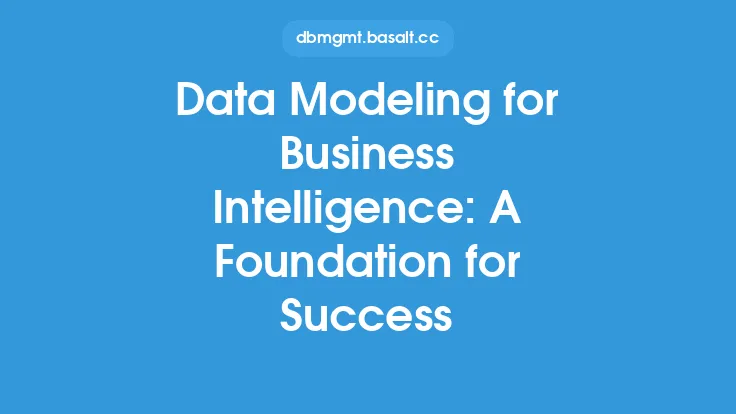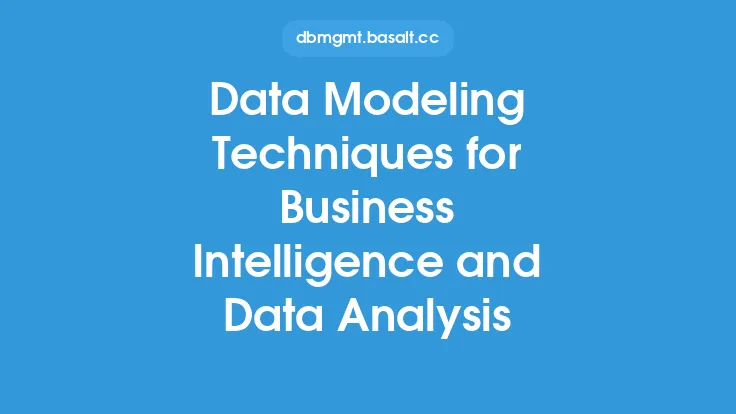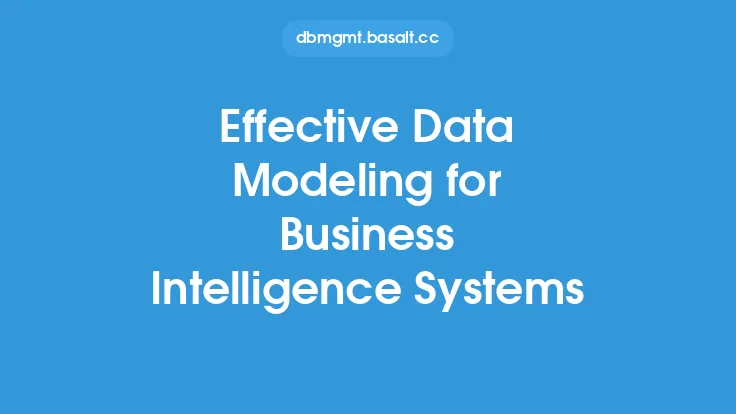Data modeling is a crucial aspect of business intelligence, as it enables organizations to make informed decisions by providing a clear and concise representation of their data. A well-designed data model is essential for business intelligence, as it allows for the creation of a unified view of an organization's data, which can be used to support strategic decision-making. In this article, we will explore the strategic approach to data modeling for business intelligence, including the key concepts, techniques, and best practices.
Introduction to Data Modeling
Data modeling is the process of creating a conceptual representation of an organization's data, which can be used to support business intelligence and decision-making. It involves identifying the key entities, attributes, and relationships within an organization's data, and representing them in a logical and consistent manner. A good data model should be able to capture the complexity of an organization's data, while also providing a simple and intuitive interface for users to access and analyze the data.
Key Concepts in Data Modeling
There are several key concepts in data modeling that are essential for business intelligence. These include:
- Entities: Entities are the objects or concepts that are being modeled, such as customers, products, or orders.
- Attributes: Attributes are the characteristics or properties of an entity, such as customer name, product description, or order date.
- Relationships: Relationships are the connections between entities, such as a customer placing an order or a product being part of an order.
- Hierarchies: Hierarchies are the relationships between entities at different levels of granularity, such as a customer being part of a region or a product being part of a category.
- Dimensions: Dimensions are the attributes that are used to analyze and aggregate data, such as time, geography, or product category.
Data Modeling Techniques
There are several data modeling techniques that can be used for business intelligence, including:
- Entity-relationship modeling: This technique involves creating a diagram that shows the relationships between entities.
- Dimensional modeling: This technique involves creating a data model that is optimized for querying and analysis, with a focus on dimensions and facts.
- Object-oriented modeling: This technique involves creating a data model that represents the data as objects, with attributes and methods.
- Data vault modeling: This technique involves creating a data model that is designed to support data warehousing and business intelligence, with a focus on hubs, satellites, and links.
Data Modeling for Business Intelligence
Data modeling for business intelligence involves creating a data model that is optimized for querying and analysis. This requires a deep understanding of the business requirements and the data that is available. The data model should be designed to support the key performance indicators (KPIs) and metrics that are used to measure business performance. It should also be designed to support data visualization and reporting, with a focus on creating a user-friendly interface for business users.
Best Practices for Data Modeling
There are several best practices for data modeling that can help ensure the success of a business intelligence project. These include:
- Keep it simple: The data model should be simple and intuitive, with a focus on capturing the key entities, attributes, and relationships.
- Use standard notation: The data model should use standard notation, such as entity-relationship diagrams or dimensional modeling, to ensure that it is easy to understand and maintain.
- Document the model: The data model should be fully documented, with a clear explanation of the entities, attributes, and relationships.
- Test the model: The data model should be tested and validated, to ensure that it meets the business requirements and is able to support the key performance indicators and metrics.
Data Modeling Tools and Technologies
There are several data modeling tools and technologies that can be used to support business intelligence, including:
- Data modeling software: Such as ERwin, PowerDesigner, or Enterprise Architect.
- Data warehousing platforms: Such as Amazon Redshift, Google BigQuery, or Microsoft Azure Synapse Analytics.
- Business intelligence platforms: Such as Tableau, Power BI, or QlikView.
- Data governance platforms: Such as Collibra, Informatica, or Talend.
Conclusion
Data modeling is a critical component of business intelligence, as it enables organizations to make informed decisions by providing a clear and concise representation of their data. By following the key concepts, techniques, and best practices outlined in this article, organizations can create a data model that is optimized for business intelligence and supports strategic decision-making. Whether you are using entity-relationship modeling, dimensional modeling, or data vault modeling, the key is to create a data model that is simple, intuitive, and easy to maintain. With the right data modeling tools and technologies, organizations can unlock the full potential of their data and make better decisions to drive business success.





